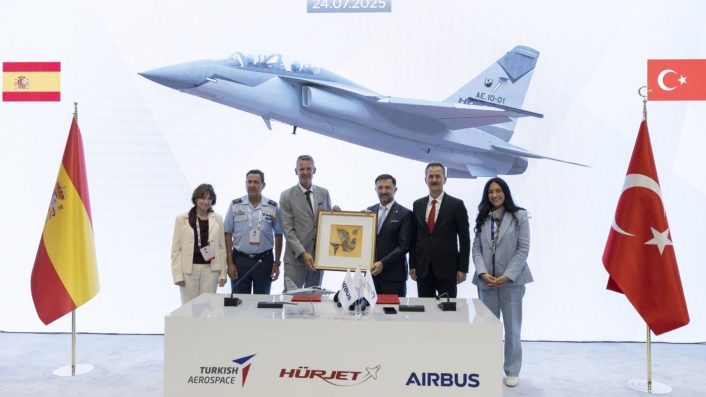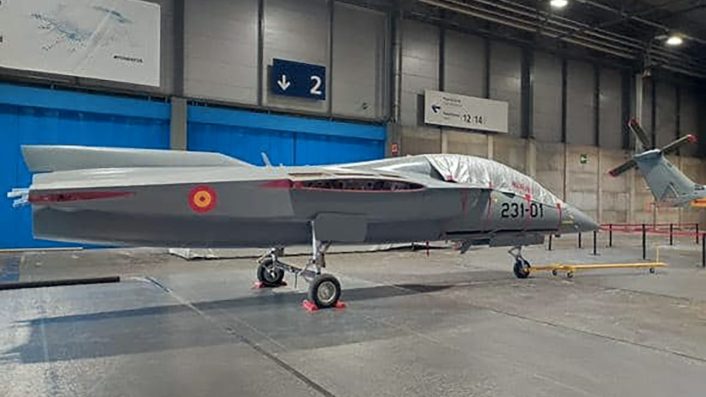Spain and Türkiye agreed on the workshare to develop the Spanish Hürjets, which will have major Spanish subsystems, ahead of the signing of the contract.
A new agreement between TAI (Turkish Aerospace Industries) and Airbus Defence and Space has now formalized the partnership between the two companies for the Spanish acquisition of the Hürjet jet trainer. The agreement was signed last week at the IDEF (International Defense Industry Fair) 2025, ahead of a final commercial deal to be signed by September or October.
Under the agreement, the Spanish Air and Space Force (SASF) will acquire up to 30 Hürjet airframes, with deliveries expected to begin in 2028. The new aircraft will replace the service’s fleet of 19 SF-5M Freedom Fighter jet trainers.
The latest agreement divides the workshare between TAI/TUSAS and Airbus. The latter is a representative for the consortium of Spanish industries that would manufacture the aircraft’s major components and sub-systems.
The ball was set rolling after Spain evaluated the Hürjet prototype between July and August 2024 at Torrejon Air Base, near Madrid. This was followed by a December 2024 Memorandum of Understanding (MoU) between Turkey’s Presidency of Defense Industries (SSB) and the Spanish Ministry of Defense, formally selecting the Hürjet as the future trainer.
Then, in May 2025, TAI revealed the full-sized model of the Hürjet with SASF markings for display at the Feindef 2025 exhibition in Spain.
TUSAŞ ile Airbus arasında, HÜRJET için iş birliği anlaşması imzalandı! 🇹🇷🇪🇸
— HÜRJET’in İspanya yolculuğu için son durak… pic.twitter.com/F44jOBw5aP
— SavunmaSanayiST.com (@SavunmaSanayiST) July 24, 2025
New agreement
According to Daily Sabah, the “agreement clarified the roles of the two companies in the Hürjet project and formalized the partnership between TAI and Airbus in Spain’s jet trainer aircraft procurement process.” Spanish and Turkish industries would cooperate to develop what is being called the broader Integrated Training System-Combat (ITS-C) that is centered around the Hürjet, in order to prepare the aircraft for Spanish use.

AvionRevue reported earlier this year that Airtificial, a Spanish aerospace company based in Cádiz, is already involved in the Hurjet project, manufacturing active and passive flight control arms. The company announced on Apr. 3, 2024, that it signed a two-phase contract worth $2.8 million to manufacture these components for the Hurjet.
Aviation Week touched upon the finer industrial-commercial aspects the MoU aims to address, saying the agreement enables both Turkish and Spanish engineers to “determine which subsystems would go into the aircraft […] depending upon the cost and time impact on the program.” This takes into account the fact that a production line in Spain is not feasible for the small number of airframes Madrid plans to buy.
During Feindef 2025 in June, agreements with Spanish companies like Aernnova, GMV, Indra, ITP Aero, Grupo Oesía, and Sener, were signed.
Spanish Hürjets
Aviation Week quoted TAI General Manager Mehmet Demiroğlu who said that a first batch of six aircraft will be delivered in a similar configuration as those meant for the Turkish Air Force (Türk Hava Kuvvetleri). This will allow them to begin the deliveries within the target date set for 2028, adding that this is the “fastest way to advance their [Spanish Air Force] needs.”

The second batch would be aligned with the technical discussions between Turkish and Spanish engineers, and will come with “certified and ready” Spanish subsystems. Eventually, all of the aircraft will be retrofitted with Spanish aerospace parts, and Demiroğlu told Aviation Week that the new agreement makes it “95% clear who will do what,” while “the remaining 5% is where the final negotiations are underway, including on certification.”
Demiroğlu predicts that the Hürjet’s development work should be complete by late 2027 or early 2028. AvionRevue reported a Jun. 27, 2025 statement by Spanish Defense Minister Margarita Robles to the Senate Defense Committee, stressing that Madrid would “co-develop” an “advanced jet trainer based on the Turkish Hürjet through a bilateral cooperation program with Turkey.”
Robles added that the “Spanish-ization of the aircraft” allows the development of a Spanish version of the aircraft with national design authority. She further highlighted the program’s economic impact of €2.887 billion in business, directly supporting 792 direct jobs, with a total employment impact of 2,614.
This is the beauty of a modern LCA and AJT jet. Hürjet, Turkiye’s first manned supersonic combat jet, has stolen everyone’s hearts with its aerodynamic aesthetics in its 2nd prototype. The new camouflage paint reflects the true identity of this aircraft https://t.co/OE8KiXuswk pic.twitter.com/2D0ado8bLt
— TR_tech (@T_Nblty) November 22, 2024
The SASF’s Hürjets would be assigned to the Ala 23 (23rd Wing) at Talavera La Real Air Base, which currently operates the 19 F-5Ms. The F-5Ms are used to train pilots as part of the Fighter and Attack Phase to fly the Eurofighter Typhoons and F-18 (Spain doesn’t use the F/A-18 Designation for its Hornets).
Hürjet advanced jet trainer
The Hürjet has so far completed 210 test flights and achieved a maximum speed of Mach 1.4. The supersonic advanced jet trainer is centered around a holistic Hürjet Training 360 System, complete with an Embedded Training System, Ground-Based Training System and Live-Virtual Constructive Training, more suited for the training of pilots that will fly on fifth generation aircraft.
Its modern interface reduces the transition time to fifth generation aircraft, while the “smart single-engine configuration enables lower fuel consumption, easier and faster maintenance, and reduced use of spare parts,” Daily Sabah said. The aircraft can touch a maximum altitude of 45,000 ft, with a payload of 6,000 lb and a range of 1,200 NM.
Türkiye will export jet trainers to Spain
Turkish Aerospace Industries (TAI) signed a partnership agreement with Airbus at IDEF 2025 to export up to 30 Hurjet advanced jet trainers to Spain.
The deal outlines each company’s role in Spain’s jet trainer procurement and aims to… pic.twitter.com/P0exgaUYzo
— The SETA Foundation at Washington DC (@SETADC) July 24, 2025
TAI says the Hürjet allows easy handling with high Angle of Attack (AoA) controllability; a full authority, Digital Fly-by-Wire Flight Control System; aerial refueling capability; Auxiliary Power Unit (APU) for autonomous operations; a full glass cockpit with Head-up Display (HUD); Helmet Mounted Display (HMD); State-of-the-art HMI (Human-Machine Interface); NVIS (Night Vision Imaging System) compatibility; datalinks and Embedded Tactical Training & Live Virtual Constructive Training systems.
Two prototypes of Türkiye’s first domestically produced jet trainer and light attack aircraft Hurjet seen in flight as they arrive in Istanbul for IDEF 2025 pic.twitter.com/FYevBMQPUh
— Türkiye Today (@turkiyetodaycom) July 20, 2025
TAI, GE Aerospace and Turkish Engine Industries (TEI) have also partnered through an MoU for the F404 -GE-102 turbofan engine to fly the Hurjet. This agreement includes local assembly and full MRO (Maintenance Repair and Overhaul) of the F404 powerplant.









